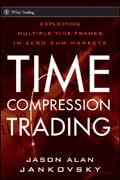
Time compression trading: exploiting multiple time frames in zero sum markets
Jankovsky, Jason Alan
Uncover profitable trading opportunities by exploiting the multiple time frames traded by different market participants In virtually all traded markets there are traders working on short-term, medium-term, and long-term perspectives.Each class of trader has different keys for entering and exiting the market. By identifying those keys and understanding where these traders intersect, a trader can spot profitable trading opportunities. In Time Compression in Trading, author Jason Jankovsky explains the structure of the market through the prism of the time frames of different trader groups. In practical terms, he showshow to identify the probable entry and exit points of short term, medium term, and long term traders. He also explains why traders should pay particular attention to the weakest and strongest hands in a market in order to trade in concert with the stronger market players. * Breaks new ground in its analysis ofmarket structure and at the same time, provides practical, actionable ideas for better trading * Reveals how to profit from the actions of market participants operating in different time frames * Discusses why traders should pay close attention to the time frames of other traders when analyzing markets If you want to learn how to trade more effectively by understanding market structure and what other traders are doing, Time Compression in Trading is a must read INDICE: Preface. Acknowledgments. Introduction. Part I: The Uniqueness of Zero-Sum Markets. Chapter 1: Basics of Zero-Sum Markets. Chapter 2: Who Is theMarket? Chapter 3: The Four Components of Market Structure. Chapter 4: The Illusion of Market Analysis. Chapter 5: The Psychology of Initiating and Liquidating a Position. Part II: The Theory of Time Compression. Chapter 6: The Development of the Theory. Chapter 7: Time Compression and Technical Analysis. Chapter 8: Forced Liquidation and Order-Flow. Chapter 9: How Leverage Increases the Potential for Forced Liquidation. Chapter 10: How Traders Lose Perspective. Part III: Exploiting Multiple Time Frames. Chapter 11: Basics of Multiple TimeFrames. Chapter 12: Three Market Potentials: Uptrend, Downtrend, and Range. Chapter 13: The Twelve Choices in Executing Trades. Chapter 14: Thinking in Probabilities. Chapter 15: Using Multiple Time Frames. Part IV: The Five Basic Market Structures. Chapter 16: Topping Market. Chapter 17: Bottoming Market. Chapter 18: Secure Uptrend and Downtrend. Chapter 19: Secure Range. Chapter 20: Conclusion. About the Author. Index.
- ISBN: 978-0-470-56494-3
- Editorial: John Wiley & Sons
- Encuadernacion: Cartoné
- Páginas: 208
- Fecha Publicación: 13/10/2010
- Nº Volúmenes: 1
- Idioma: Inglés
